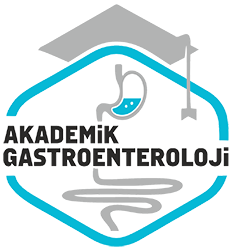Perkütan endoskopik gastrostomi sonuçlarimiz: 49 olgunun irdelenmesi
Results of percutaneous endoscopic gastrostomy: investigation of 49 cases
Özet
Giriş ve amaç: Enteral beslenme, çesitli nedenlerle oral yoldan beslenemeyen ama gastrointestinal sistem fonksiyonlari normal olan olgularda uygulanabilecek bir yöntemdir. Gereç ve yöntem: Bu çalışmada Gastroenteroloji Bilim Dalimizda Nisan 2000-Eylül 2002 tarihleri arasında en az 4 hafta süreyle oral beslenemeyecegi öngörülerek PEG yerlestirilmesi planlanan 53 olgu retrospektif olarak değerlendirilmıştır. Bulgular: Olgularimizin 49’una PEG islemi yapilmıştır. Dört olguda; dev mide ülseri varligi, transillüminasyonun saglanamamasi, batinda arter ponksiyonu ve nasofarenks ca nedeniyle endoskopun yutturulamamasi sonucu PEG islemi yapilamamıştır. Alti olguya özofagus üst uçta darlik yaratan tümör nedeniyle buji dilatasyonunu takiben PEG islemi yapilmıştır. Hastaların tümü ortalama 100 gün (0-585 gün) takip edilmişlerdir. Onalti olgu takip süresince primer hastalıklari nedeniyle eksitus olmuştur Bu olgularin 7’si ilk 30 gün içersinde (% 14,3), 9’u 30 günden sonra (% 18,4 ) kaybedilmıştır. Olgularin ortalama yaşama süresi 51 gün bulunmustur (0-420). On olgumuzda yeterli oral alim basladigi için PEG seti dogrudan çekilerek çikarilmıştır. Setin takili kalma süresi medyan 87 gündür (35-347 gün). On olguya ulasilamadigi için son durumlarini ögrenmek mümkün olmamıştır. Kalan 12 olgu, ortalama olarak 410 gündür takip altındadir (37-585). Serimizde iki olguda antibiyotik tedavisi gerektirecek yara çevresi enfeksiyonu, 1 olguda gömülmüs tampon (burried bumper) sendromu, 1 olguda kateter kenarindan hafif sizdirma, 1 olguda da pnömoperituan ortaya çikmıştır. Toplam minör komplikasyon % 8,2, majör komplikasyon oranimiz (gömülmüs tampon sendromu) % 2 saptanmıştır. Sonuç: Sonuç olarak, PEG genel anestezi gerektirmeyen, gereginde yatak basinda da kolayca uygulanabilen, düşük morbidite ve mortalite oranlari olan bir islemdir.
Abstract
Background and aim: Enteral feeding is a method to deliver nutrients and is used for patients with a normal functioning gastrointestinal tract, but who are unable to take food orally due to various reasons. Material and methods: In this study, we evaluated 53 patients in our department who would be unable to perform oral feeding for at least 4 weeks for PEG procedure between April 2000 and September 2002 retrospectively. Results: PEG procedure was performed on 49 of the 53 selected patients. The other four patients had either a giant gastric ulcer, inadequate transillumination, abdominal arterial puncture or nasopharyngeal neoplasm induced upper esophageal narrowing that prevented the PEG procedure. Six of 49 patients who had upper esophageal narrowing due to a neoplasm, received bougie dilatation before PEG procedure. All patients were followed for a median 100 of days (0-585 days). Sixteen of the patients died as a result of primary pathologies. Seven of the patients died within the first 30 days (14.3%), 9 of the patients died after the first 30 days (18.4%). Average surviral for the patients was 51 days (0-420 days). Ten of the patients gained their oral feeding ability back and therefore PEG set was removed. Average PEG carrying time for the patients was a median of 87 days (35-347 days). We are unsure of the final condition of 10 patients that we were unable to contact. We have continued to follow the other 12 patients to a median of 410 days (37-585 days). Complications: Two of the patients had wound infections which needed antibiotic therapy, one had burred bumper syndrome, one had marginal leakage of the catheter, one had pneumoperituan. Our overall minor complication rate was 8.2%, and major complication rate 2% (buried bumper syndrome). Conclusions: PEG is a procedure requiring no general anesthesia, which can be easily performed at the bedside, and has low morbidity and mortality rates.



